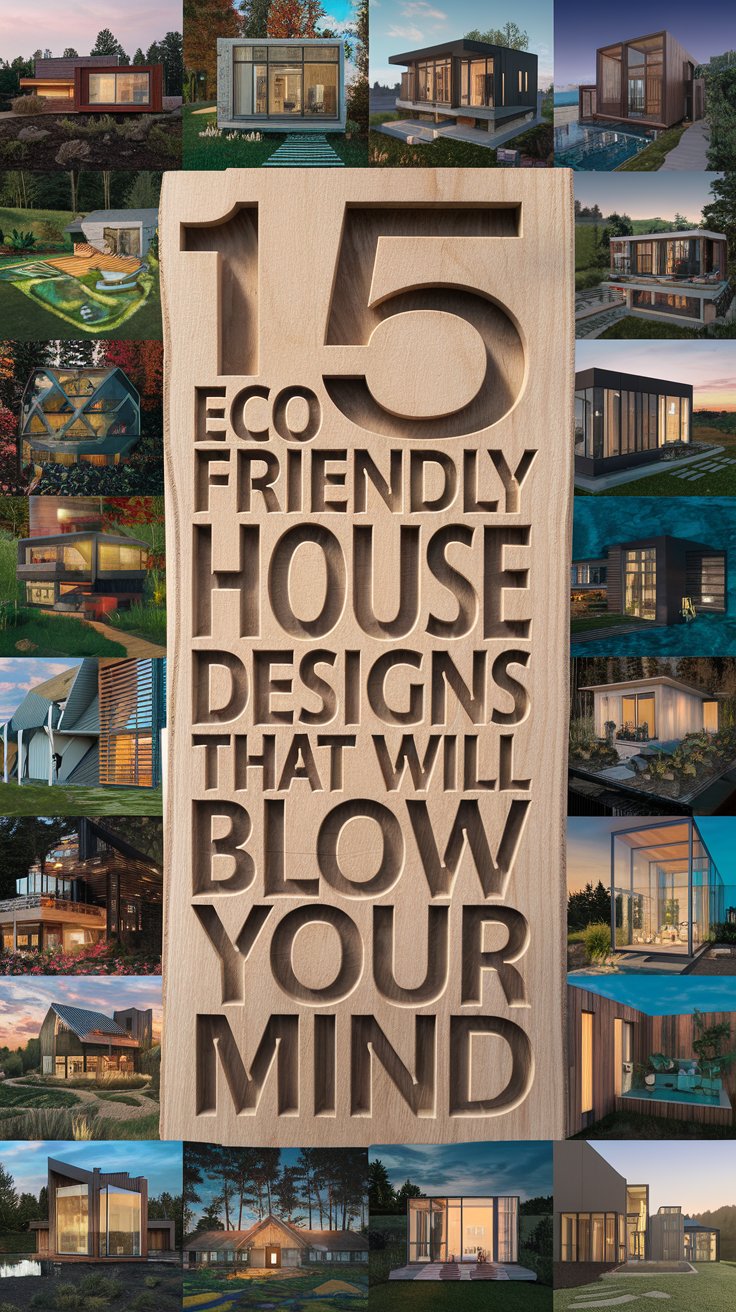type
status
date
category
slug
summary
Pinterest Topic
Pin Title
Pinterest Tag
Facebook Post
Latest Pin Date
Latest Pin No.
Pin Image
Total Pin Images
All Pins Posted
All Pin Images Created
tags
icon
password
comment
humanize
Okay, let’s be real for a sec—how many times have you unlocked your phone, scrolled for 2 minutes, and felt like the world’s just dumping a bucket of “ugh” right on your chest? Last week, I did that exact thing. First post? “Ocean levels rising faster than predicted.” My stomach dropped. Second? “Plastic found in 90% of deep-sea fish.” I frowned so hard my eyebrows hurt. Third? A local reel of my go-to coffee shop—you know, the one with the lavender lattes that taste like a hug—using 500 plastic straws a day. I sighed so loud my cat, Mochi, lifted her head. She’s a chonky tabby who thinks napping is a full-time job (her favorite spot’s the sunny windowsill, where she curls into a little fur ball). She stretched one paw, gave me this look like, “Dude. You’re gonna wake the bird outside my window,” then flopped back down. Classic Mochi.
Cue the existential slump. I sat there, phone burning in my hand, thinking, “Is there anything I can do that doesn’t feel tiny? My apartment’s just a box—how can that even matter?” But then… wait. What if our homes weren’t part of the problem? What if they were the fix?
Full disclosure: I didn’t hop on a plane to find these (carbon footprint, hello? I once felt guilty for using a plastic fork at a food truck—no way I’m adding flight emissions to my “eco-shame” list). I did this from my couch. Fuzzy cream-colored socks with little stars (don’t judge—they’re soft as a cloud), chamomile tea (I added way too much honey, but it’s my couch, my rules), laptop propped on a pillow that’s seen better days (it has a coffee stain I’ve been ignoring for 6 months). And let me tell you—I dug up 15 eco-friendly houses that aren’t just “good for the planet”… they’re cool. Like, “I’d daydream about living here while I’m stuck in a work meeting” cool. No preachy lectures, no “you’re doing it wrong” vibes—just laughs, “whoa, that’s genius!” moments, and maybe a little nudge to add one tiny green thing to your space.
Let’s dive in, yeah?
1. The Passive Solar Powerhouse: Soaking Up Sunshine (Not Your Bank Account)
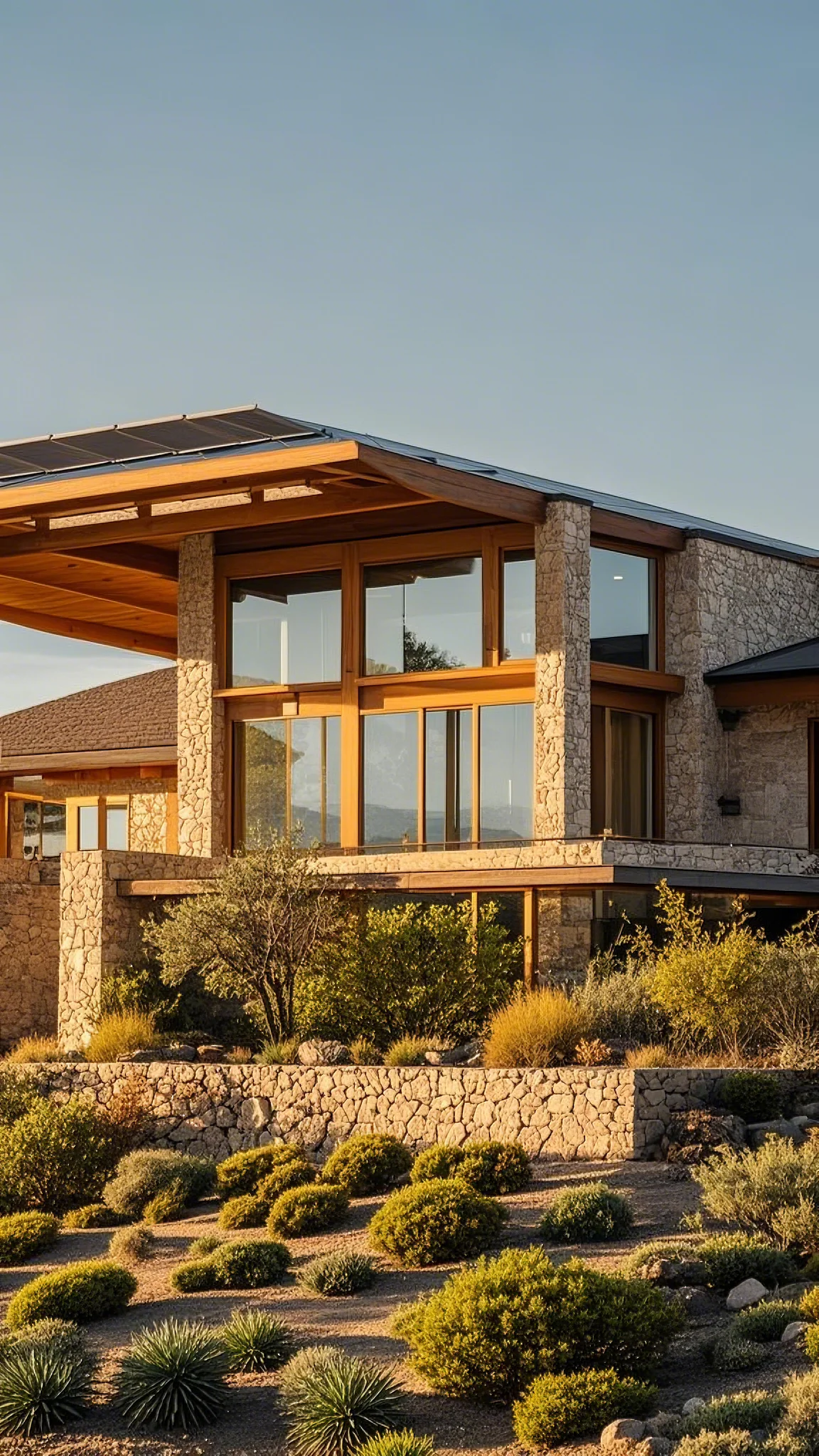
Let’s start simple. Because simple can be brilliant—like putting peanut butter on toast, or wearing sweatpants on a Sunday.
Passive Solar Design is like your house becomes a sun-worshipper—but the chill, low-maintenance kind. No fancy gadgets, no complicated apps. Just smart planning.
Here’s how it works: South-facing windows act like giant, silent solar panels, sucking up that winter sun like a sponge soaks up water. Then thick walls—think concrete or stone—hold onto that heat like a big, quiet battery. So when the sun goes down? Your house stays toasty, no noisy heater needed. And in summer? Those overhangs above the windows kick in, shading the glass so you don’t feel like you’re living in an oven. It’s like your home wears a chunky knit sweater in January and a wide-brimmed hat in July.
I visited a friend with this setup last winter. Let me paint the picture: Her living room had a window seat lined with a hand-knit blanket (her mom made it—lots of cream and navy stripes, and it smelled like lavender detergent). The sun was streaming through so bright, it made her bookshelf glow—like someone turned on a soft spotlight. She had this tattered copy of The Secret Garden on the shelf—same one I had as a kid, with the faded cover and a little tear on the spine—and the light hit the pages just right, like the book was smiling. I sat there with a mug of apple cider (she had a pot simmering on the stove—cinnamon, cloves, the whole cozy deal) and forgot all about the snow piling up outside. No noisy heater blowing (mine sounds like a jet taking off at 6 AM—seriously, I’ve woken up thinking there’s a plane in my living room). Just soft light and warmth, and the quiet bubble of the cider pot.
And her energy bill? Half of mine. My winter bill’s usually $180—hers? Barely $90. I almost asked to move in on the spot. Plus, who doesn’t love a house that’s basically a stylish sunflower? Turning toward the light, no extra effort needed.
2. The Earthship Escape: Building Dreams Out of… Tires? (Seriously!)
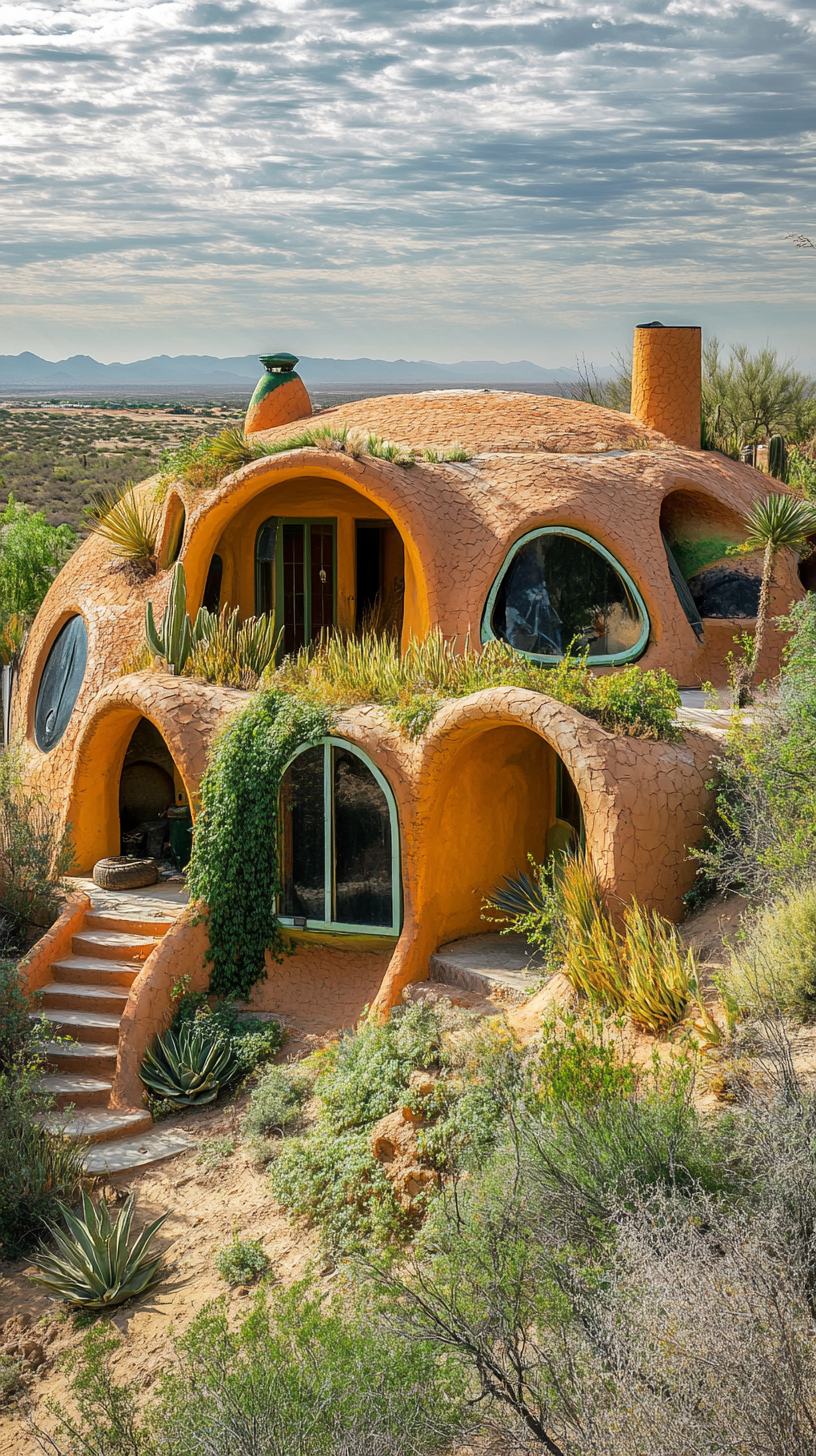
Okay, let’s get one thing straight: I used to think “recycled homes” meant a pile of junk held together with hope and duct tape. When I first heard “Earthships are made of tires,” I thought of my uncle’s backyard. He’s got a stack of old tires he swears he’ll “use for something someday” (it’s been 5 years, and they’re just collecting leaves and a stray cat that likes to nap on top). But Earthships? They’re not messy. They’re not rickety. They’re off-grid fortresses of sustainability. And yes—they’re built with tires.
Here’s the magic: You take old, used tires, pack ’em full of dirt (like, really pack ’em—think of it as giving the tire a cozy dirt hug, the kind that makes it feel sturdy), stack ’em like bricks, and boom—walls stronger than some traditional houses. I touched one once, and I was shocked—no squish, no creak. Just solid, like tapping a brick wall. But that’s just the start. Earthships make their own electricity (solar panels + a little wind turbine that looks like a tiny windmill), collect rainwater for drinking and washing, and even treat their own wastewater. It’s a tiny, self-contained ecosystem you can live in—like having a little planet of your own.
I saw photos of one last year that made my jaw drop. The living room had a fireplace made from old glass bottles—tall ones, short ones, all different colors: green, blue, amber. When the sun hit it around 4 PM, the whole room lit up like a stained-glass window. Little rainbows danced on the floor, and I swear, it felt like being in a museum. I texted my roommate immediately: “We need to move into a tire house. Now.” She replied with a meme: a cat sitting on a pile of tires, side-eyeing the camera, captioned “Is this your new midlife crisis?” Fair. But I stand by it.
Imagine telling your friends, “Oh, this? Just a house made of tires,” then showing them that fireplace. Their jaws will hit the floor. And let’s be real—if the world ever goes a little sideways? You’ll be over here with your own water and power, sipping tea like it’s no big deal. Eco-bragging rights? Unlocked.
3. The Tiny House Titan: Living Large, Stepping Lightly
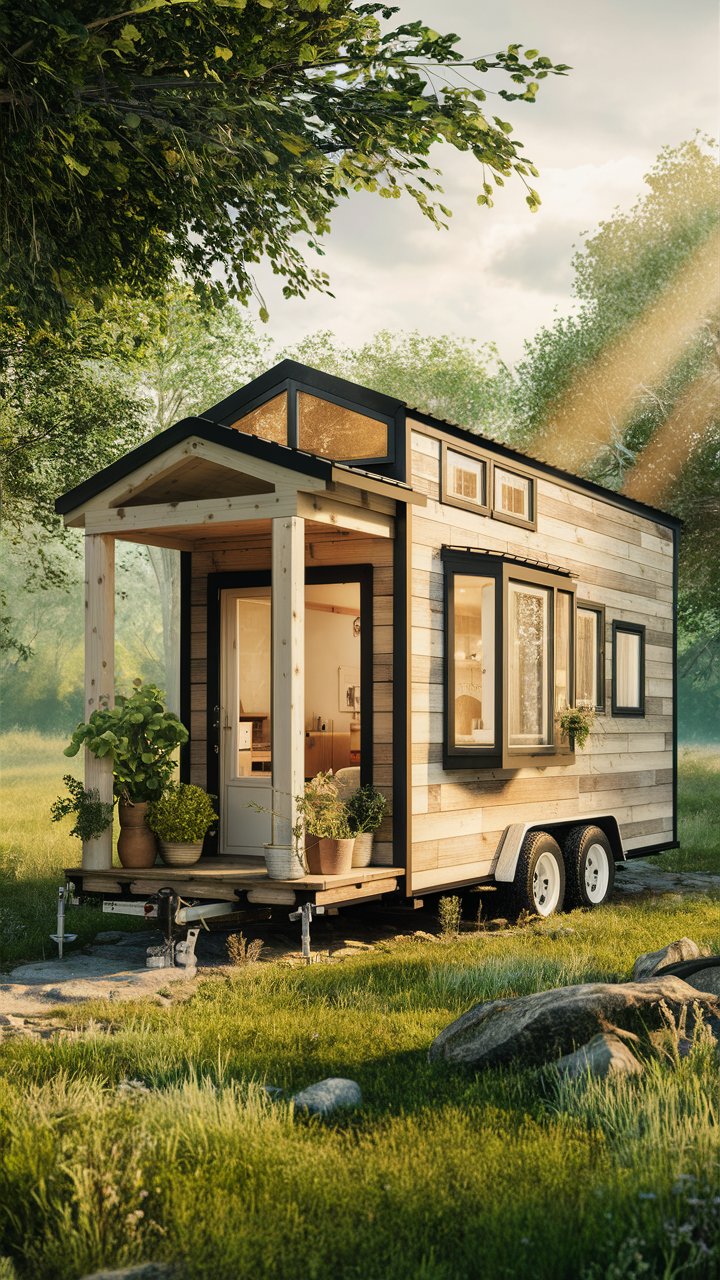
Who needs 3,000 square feet of “stuff storage”? I used to live in a 900-square-foot apartment, and let’s be honest—I had a closet full of clothes I never wore. There’s this neon green dress in there (I bought it for an outdoor concert in 2019—my favorite band was playing, I’d been hyped for months, then it rained all day, so I wore a hoodie instead). It still has the tag on. I tried it on once, looked like a glow stick at a funeral, and stuffed it back. Then there’s the blender—impulse buy from a late-night Amazon scroll. I thought I’d make smoothies every morning. Spoiler: I made one, it tasted like cardboard mixed with spinach, and now it lives in the back of my cabinet. And three extra mugs? I only use the chipped blue one with a cat on it.
Tiny Houses fix that. They’re all about “less is more”—but not the boring “I have no personality” less. Every inch counts. Built-in couches that turn into beds. Shelves that hide laundry baskets (genius—no more staring at a pile of dirty clothes while you watch TV). Tiny kitchens that feel cozy, not cramped—like a little nook where you can cook without tripping over a trash can. They’re made with sustainable stuff (bamboo, reclaimed wood) and use barely any energy. No more paying to heat a spare bedroom you only use for storage (mine was just a pile of boxes and that neon dress). No more “where did I put my keys?” panic—there’s only one drawer for them.
I toured a tiny house last month—this cute one on wheels, with a little porch strung with fairy lights that twinkled even in the daytime. The owner, a girl named Lila, showed me her “hidden” storage: a bench that lifted up to hold her hiking boots (she had three pairs—all scuffed from trails), a shelf under the bed for her books (mostly fantasy novels, which I totally judged her for… then asked for recommendations). She said she used to live in a 1,500-square-foot house and “felt lost in it.” Like, she’d buy things just to fill the space, and then she’d forget she had them. Now? She moves the tiny house every few months—parked it in a meadow last summer (she sent me photos of fireflies at night), a mountain town this winter (she skis every weekend). “I don’t miss the stuff,” she said, handing me a glass of lemonade. “I miss the space to breathe.”
I left there thinking about that neon green dress. Maybe it’s time to donate it. And that blender? Yeah, it’s going to Goodwill. Minimalist living never looked so fun.
4. The Vertical Garden Villa: Breathing Easier, Greening Up Your Walls
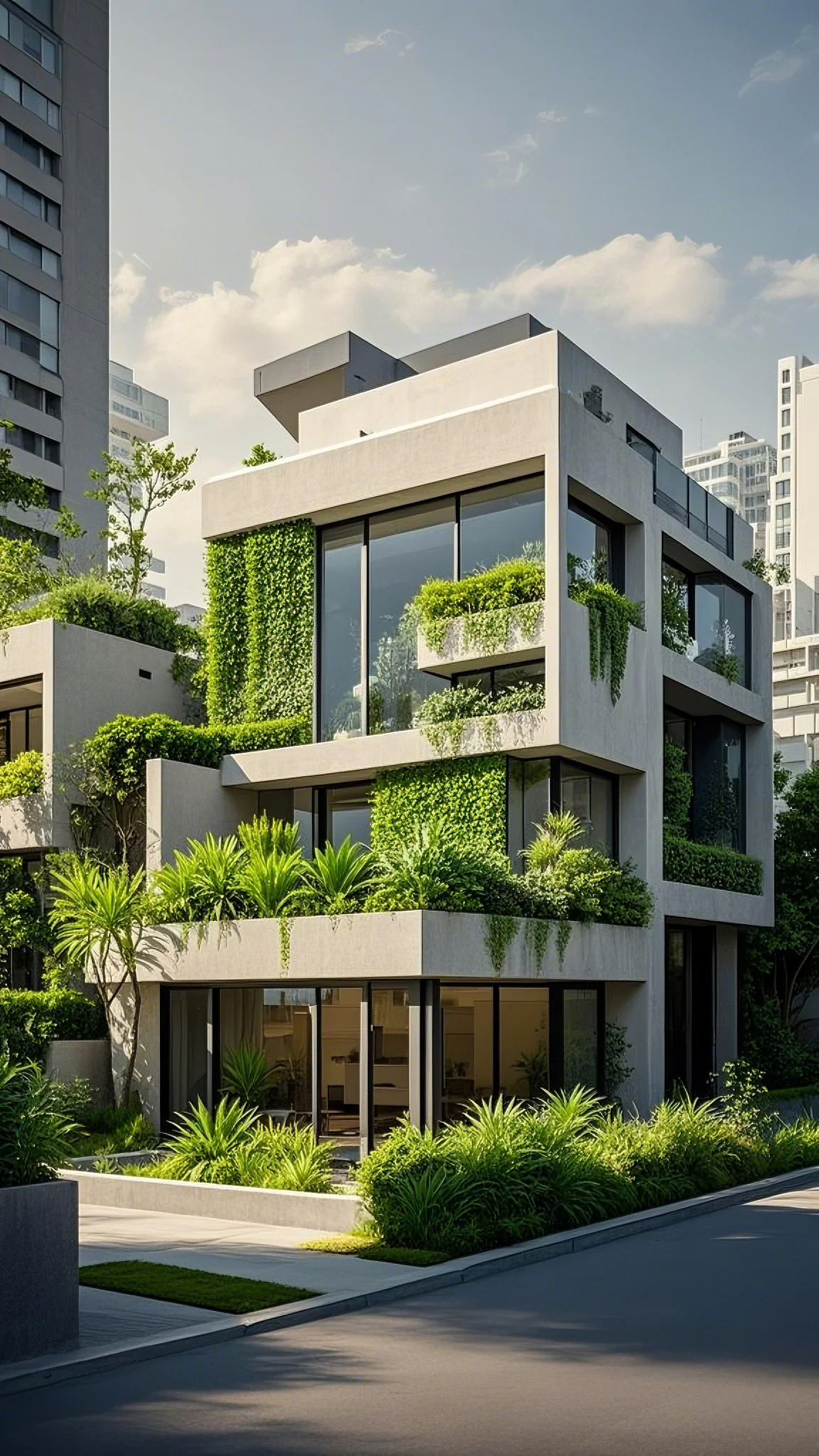
If you live in a city, you know the struggle. I’m a condo dweller—my “outdoor space” is a balcony the size of a yoga mat. I have one potted succulent (his name is Gary) and a tomato plant that’s been clinging to life for months (I forget to water it sometimes… don’t tell Gary). Gary’s a little leggy, too—he leans toward the window like he’s trying to escape the concrete jungle. I stare at concrete all day—office walls, sidewalks, the building next door—and sometimes I forget what real grass smells like. Like, I’ll walk past a park and stop for a second, just to inhale that “fresh cut” scent.
Then there’s Vertical Gardens (aka living walls). They’re exactly what they sound like: plants growing up the side of your house, or even inside. And they’re not just pretty—they’re hard workers. They filter city smog (goodbye, that scratchy throat feeling after walking to work past 100 cars). They muffle street noise (so long, 6 AM garbage trucks that wake me up mid-dream about winning the lottery). They insulate your home (no more freezing walls in winter that make me wear socks indoors—even though I’m a “no socks in the house” person).
My neighbor, Maria, put a vertical garden on her balcony wall last year. She grows mint, lavender, and even a little rosemary—all in these tiny pots that stack up like a green staircase. Every time I walk past her door, I can smell it before I see her—fresh, herby, like summer in a jar. Last week, she knocked on my door with a handful of mint, still dewy (she’d just watered it). “Try it in iced tea,” she said. I did. And let me tell you—grocery store mint tastes like cardboard compared to this. It was bright, fresh, like I picked it straight from a farm. I even added a little to my oatmeal the next morning. Game changer.
And the looks? Her balcony stands out like a little green oasis in a sea of gray. My friends always ask, “Who has the mint wall?” when they come over. I point to Maria’s place and say, “That’s the one.” They’re always jealous. Pun totally intended.
5. The Recycled Material Retreat: Trash to Treasure, Home Edition
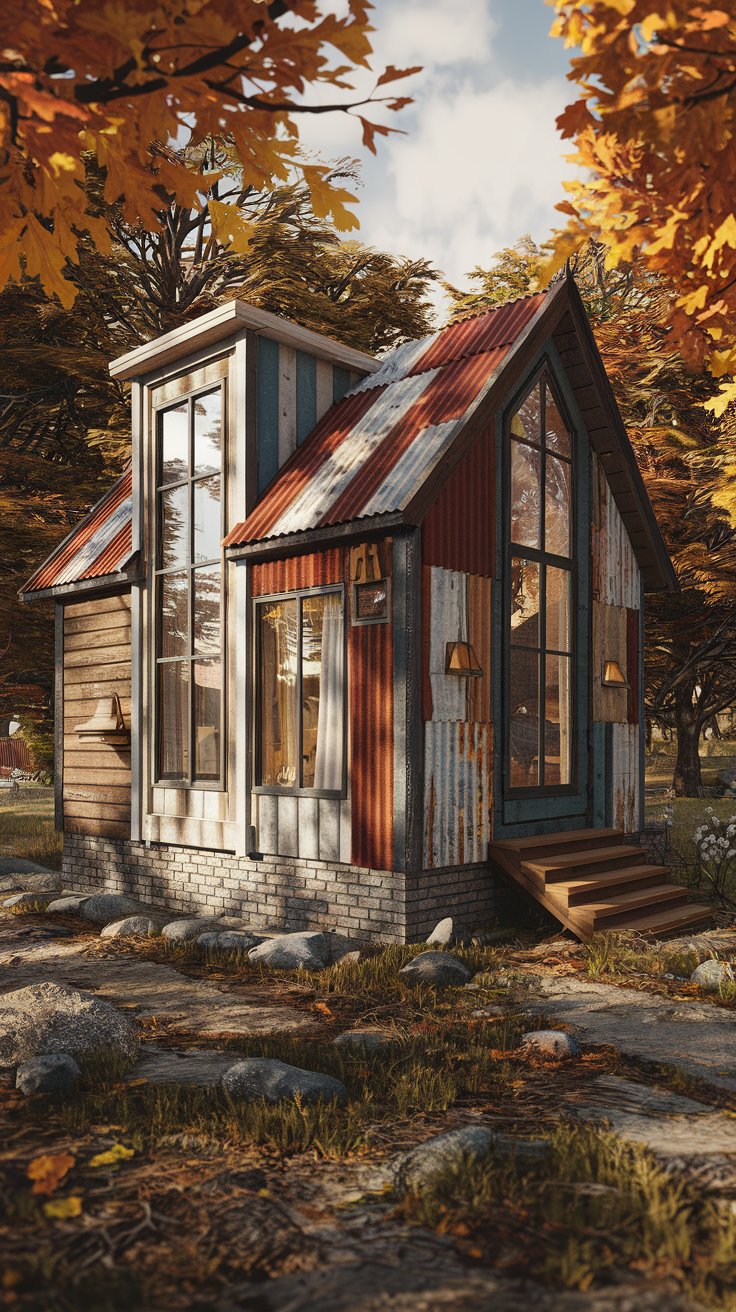
Who says trash can’t be beautiful? I used to think “recycled homes” meant a lot of duct tape and hope—like that time I tried to fix a broken lamp with tape and it fell apart 5 minutes later. But
Recycled Material Homes
take “reduce, reuse, recycle” to a whole new level—and they’re way cooler than you think.
We’re talking reclaimed barn wood for floors—each scratch tells a story. My cousin has a barn wood table; he swears one mark was from a horse named Bessie in 1992. “She hated that barn cat,” he says, pointing to a little crescent-shaped scratch. “Swiped at it once, hit the table instead. We still laugh about it.” He tells that story every time someone sits at the table, even if they’ve heard it before. Then there’s shipping containers for walls—painted bright white, they look modern, not like something that sat in a port in the rain (I’ve seen those—they’re rusty and sad). And beer bottles for windows? When the sun hits them, the room glows amber—way better than that chandelier I have that collects dust (I dust it once a month, and it’s still dirty. I think it’s a lost cause).
My cousin built a bookshelf from old pallets last year. He spent a weekend sanding them—got a tiny splinter (complained about it for a week, said it “ruined his life”) and used a dinosaur band-aid to cover it (he’s 32, but dinosaur band-aids are non-negotiable). When he finished? It’s the most talked-about piece in his house. It has this rustic vibe that goes with his vintage record collection—he has a Fleetwood Mac record that fits perfectly on one shelf, like it was made for it. Every time someone comes over, they’re like, “Where did you get that?” He grins and says, “Pallets I found behind a hardware store.” Cue the impressed gasps.
Imagine an entire home like that. No two are the same—each one has a history. You’re not just buying a house; you’re giving forgotten things a second chance to shine. And let’s be real—you’ll never get tired of telling guests, “This wall? Made from old soda cans.” They’ll never believe you… until they touch it.
6. The Bamboo Beauty Bungalow: Strong, Sustainable, and Seriously Chic

I used to think bamboo was just for beach mats and chopsticks. The flimsy kind that break when you try to pick up a dumpling. I once broke three chopsticks in a row at a Chinese restaurant—my friend laughed so hard she snorted, and the waiter had to come over and show me how to hold them properly. I still felt awkward, like I was holding them wrong on purpose. But bamboo? It’s a sustainable superhero. And
Bamboo Beauty Bungalows show exactly why.
Here’s the deal: Bamboo grows fast. Like, 3 years fast (compared to 20+ years for hardwoods—think how long that is. That’s a whole college degree, or two cats aging). It’s stronger than oak—my friend has a bamboo cutting board, and it’s lasted 5 years with zero scratches (I’ve had plastic ones that crack after 6 months). It’s naturally resistant to bugs (no more calling an exterminator for termites—remember when my sister had termites? She cried for a week, thought her floor was going to collapse. Turns out it was fine, but she still talks about it like it was a disaster movie). And it has this warm, golden color that makes any room feel sunny—even on a rainy day when you’re stuck inside, scrolling through bad news.
I stayed in a bamboo cabin last summer up in the mountains. It poured rain for two days straight—like, “can’t see the trees outside” rain. I was convinced I’d be cold and damp, stuck in a “camping gone wrong” vibe (I hate camping—bugs, dirt, no Wi-Fi). But nope. The inside felt cozy and bright, like being wrapped in a warm blanket. The walls had this soft, slightly rough texture—way nicer than the drywall in my apartment (which feels like it’s one bump away from cracking). And the whole place smelled like fresh earth—no fake “linen breeze” air fresheners needed (I hate those—they make my nose itch).
I took a nap on the couch one afternoon. The rain hit the bamboo roof, and it sounded like a lullaby—soft, steady, not too loud. I slept for 2 hours—something I never do (I’m a “10-minute power nap” person). When I woke up, there was a mug of hot cocoa on the table (the cabin owner left it—sweet, right? It had little marshmallows that were slightly melted). I sipped it and stared at the rain, and for a second, I forgot about work emails and deadlines and that neon green dress in my closet.
And the best part? You don’t have to live in a tropical place to love it. Even in Ohio (where winters are freezing enough to make your nose hair stick together!), a bamboo house with good insulation feels like a little slice of paradise. It’s proof that eco-friendly materials can be both practical and pretty.
7. The Straw Bale Sanctuary: Insulation That's Naturally Awesome
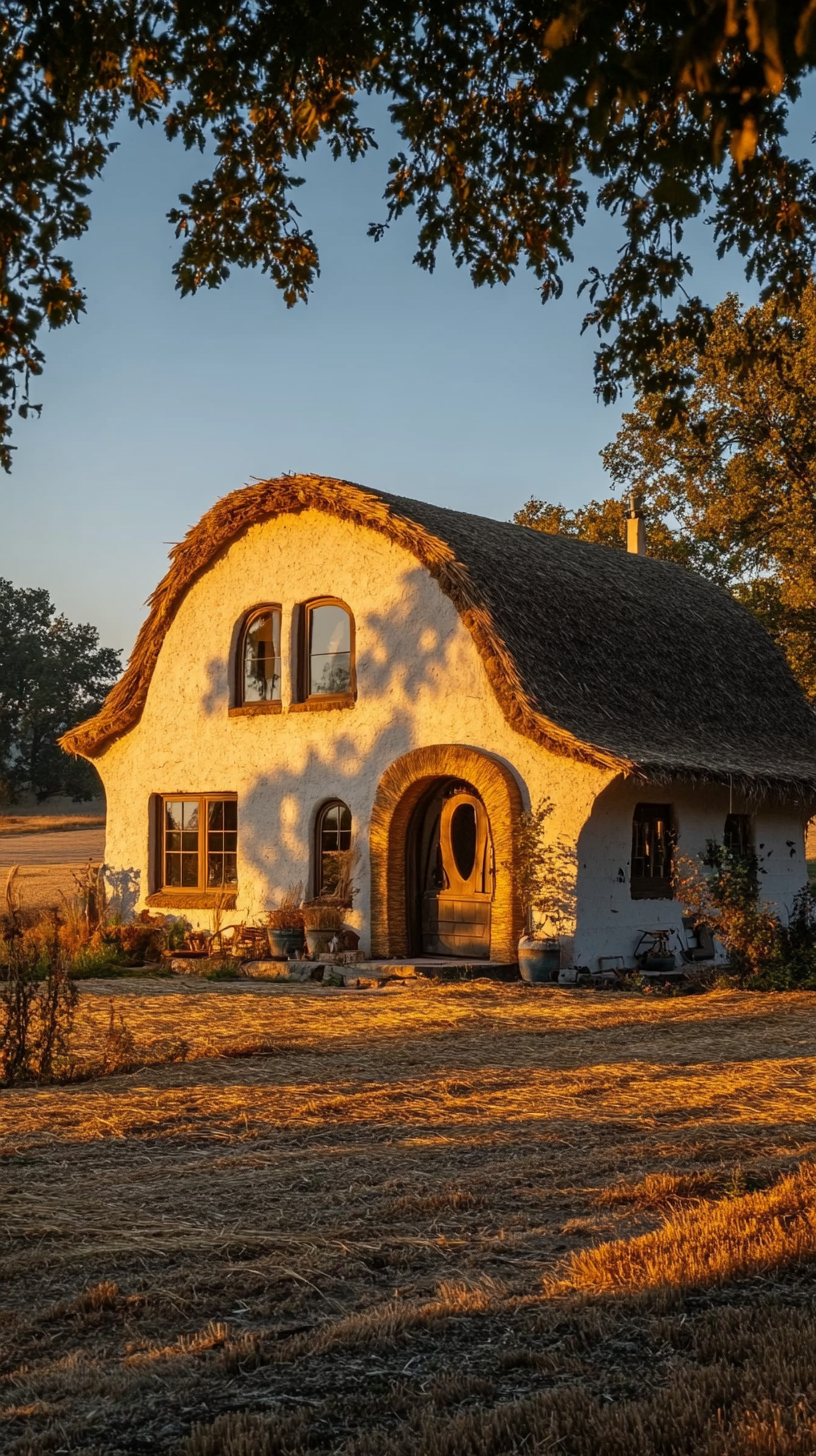
Forget fiberglass. I once helped my dad fix the attic, and I touched fiberglass by accident. I spent an hour scratching my arms like a cat with fleas—they were red and itchy for days. My dad laughed and said, “I told you to wear gloves.” I didn’t listen. Lesson learned: Always listen to your dad about gloves.
Straw Bale Homes use good old-fashioned straw—yes, the same stuff cows love to chew on—and turn it into amazing insulation. Straw bales are thick, so they keep your house warm in winter and cool in summer. No more cranking the thermostat and watching your bill go up (I once cried when I saw my winter bill—$200 for heat? That’s a month of lattes!).
My aunt stayed in one last year, and she wouldn’t stop talking about it when she got back. We were at dinner—she was stabbing her salad like she was making a point—and said, “It’s like living in a giant down comforter. I never touched the thermostat—not once.” Even when it snowed outside, the living room stayed warm. “In the afternoon, the sun came through the windows and made the walls glow,” she said. “It felt like magic. Like the house was giving me a hug.”
She also said it’s quiet. Like, “I couldn’t hear my neighbor’s dog barking at 5 AM” quiet. If you’ve ever lived near a dog that barks at 5 AM (looking at you, Mr. Jenkins’ golden retriever Max), you know that’s a miracle. Max barks at everything: squirrels, mailmen, even leaves. I once woken up to him barking at a maple leaf that was just floating by—like it was a trespasser. So quiet? Worth every penny.
And they’re cheap! Straw is easy to find in most rural areas—my uncle could probably get a truckload from his farm for next to nothing, and he’d throw in a dozen eggs for good measure (he has chickens—they lay the best eggs, with bright yellow yolks). Plus, the look? Rustic, textured, like a cozy cabin in the woods. You can plaster them with clay (for a natural look) or paint them any color. My aunt said one she saw was painted soft blue, and it looked like a little piece of sky in the trees. I’d move in in a heartbeat.
8. The Rammed Earth Residence: Ancient Technique, Modern Appeal
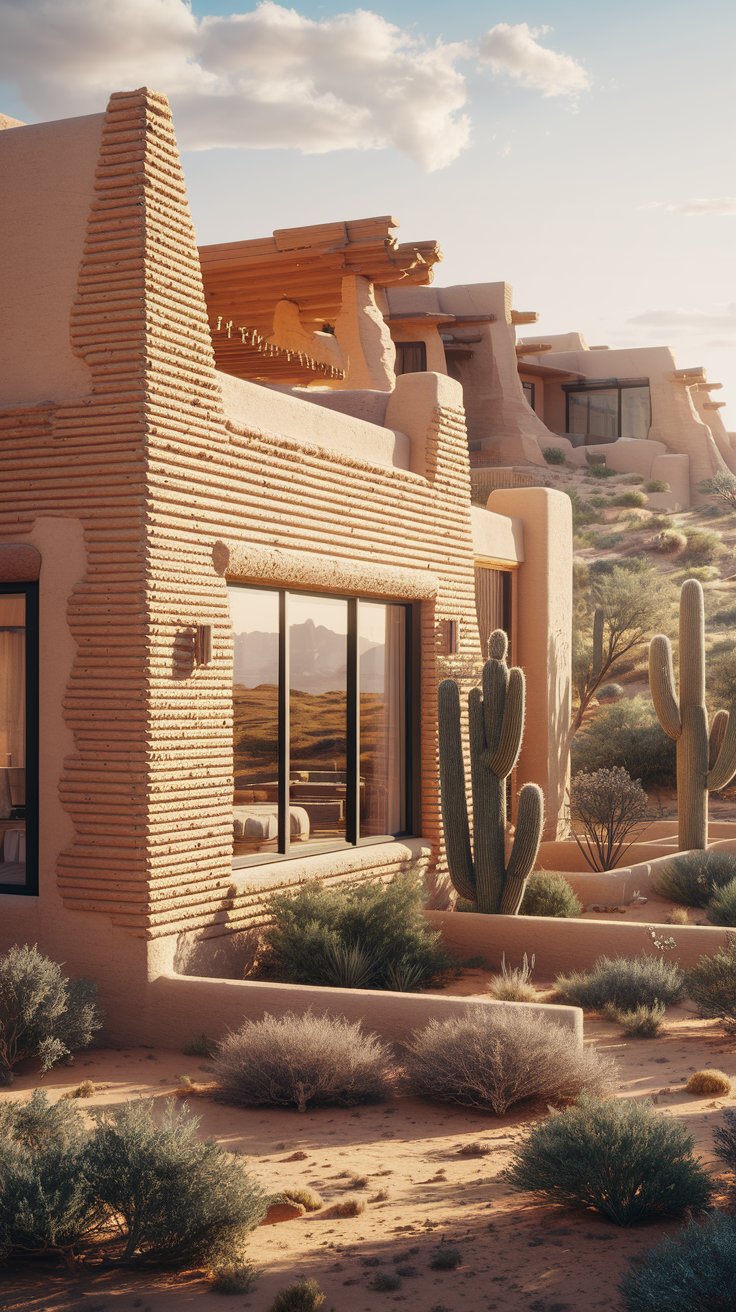
Let’s go old-school. Like, “ancient civilizations built forts with this” old-school.
Rammed Earth Homes use a building technique that’s been around for thousands of years—but it’s still totally modern. No, it doesn’t look like a cave. It looks like a work of art.
Here’s how it works: You mix soil, gravel, and clay, then pack it tightly into wooden forms. Think of it like making a giant brick, but bigger. Once it dries, you remove the forms, and you’ve got walls that are thick, durable, and naturally beautiful. The walls have little flecks of rock and clay, so every one looks like a unique painting—no two walls are the same. It’s like having a gallery in your living room, but you can touch the art.
I saw a rammed earth house last year when I was road-tripping through Arizona with my cousin. We were driving down a dusty road, listening to an old mix CD (my cousin made it in high school—lots of 2000s pop), and when we saw the house, we hit pause mid-song. It was nestled in the desert, looking like it grew out of the ground. No bright colors, just earthy tones that blended in—like it belonged there. We pulled over (my cousin was as curious as I was—we’re both suckers for weird houses) and knocked on the door. A woman named Clara answered—she was wearing a sunhat and holding a watering can—and invited us in.
Inside? It felt like being inside a work of art. The walls had little flecks of rock and clay—one had a tiny red stone that looked like a ruby. I took a photo of it and sent it to my mom, who texted back, “Is that a real ruby? Bring it home!” (It wasn’t. But I let her believe it for a day.) Another wall had a chunk of gray gravel that my cousin swore was “a dinosaur bone.” Clara laughed and said, “It’s just gravel—but I’ll let you believe it’s a dinosaur bone if you want.” She was nice like that.
She told us the house had been standing for 30 years, and she’d never had a problem with it. “It’s tough,” she said, handing us glasses of iced tea (it was 90 degrees outside, so that tea was a lifesaver). “And it stays cool in the summer, even when it’s 100 degrees outside.” I stood there sipping my tea, thinking about my apartment—July turns it into an oven. I once baked cookies on the windowsill (no joke—they were crispy, but edible). I was low-key jealous.
Rammed earth is old-school, but it’s still totally modern. Proof that sometimes the best ideas are the ones we’ve had for thousands of years.
9. The Green Roof Getaway: Roofing That Gives Back to Nature
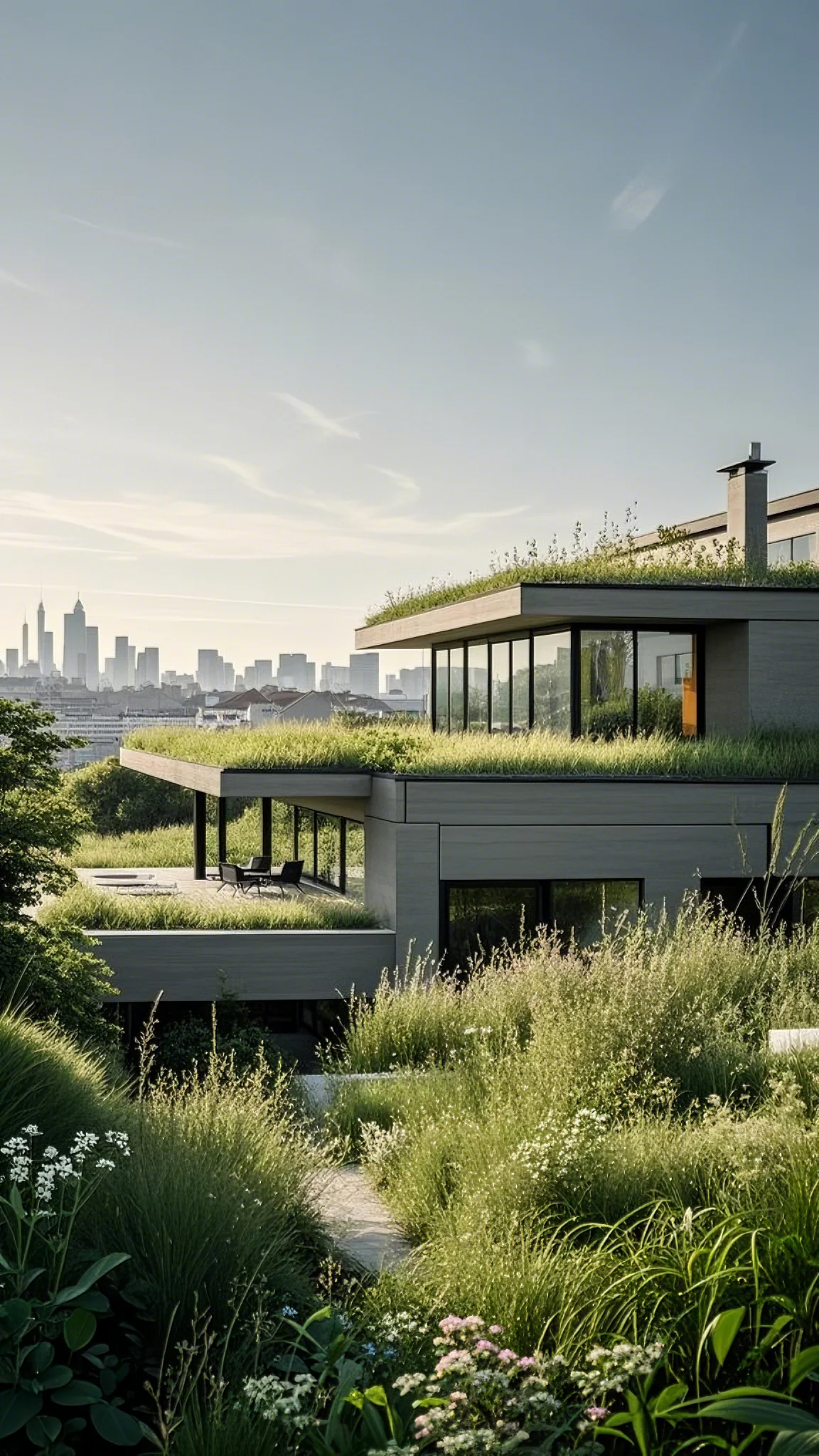
Why have a boring asphalt roof when you can have a garden on top of your house? I used to think green roofs were just for fancy hotels—you know, the ones with infinity pools and room service that brings you champagne at 2 PM. But Green Roofs are a game-changer for eco-friendly living—and they’re way more accessible than you think.
First, they insulate your home. My friend Jake has one, and his AC bill in summer is half of what his neighbors pay. Last year, it was 95 degrees outside—hot enough to fry an egg on the sidewalk (he tested it, don’t ask. The egg didn’t fully fry, just got runny, and he sent a photo to our group chat with the caption “Summer in the city”). His house? A cool 72. He said he didn’t even turn the AC on until 6 PM. I was over there once, and it felt like a different planet—my apartment was 85 degrees that day.
Second, they absorb rainwater. No more runoff that makes the sewers flood—remember last spring, when it rained for a week and I had to wade through puddles to get to my car? My shoes were soaked for days, and I had to air them out on my balcony (Gary judged me for it). Jake’s green roof soaks up most of the rain, so his yard stays dry. No puddles, no soggy shoes.
Third, they’re a habitat for bees and birds. Jake says he sees hummingbirds every morning—tiny, with iridescent green backs that shine in the sun. “I thought they were butterflies at first,” he said. “Then I realized they were too fast.” He even put a little bird feeder up there—now he has sparrows visiting too. He sends me videos of them sometimes, and I watch them while I’m eating lunch at my desk. It’s the highlight of my workday.
Fourth? They look amazing. Imagine looking out your bedroom window and seeing a roof covered in grass, flowers, and even small shrubs. It’s like having a park right above you—no more staring at a boring asphalt roof that gets hot enough to burn your hand if you touch it (I’ve done that. Ouch).
Oh, and bonus: You can grow food up there! Jake plants tomatoes and basil on his green roof. He makes pesto every summer, and it tastes way better than store-bought (which always feels like it’s been sitting in a jar for months). I went over for dinner once, and he climbed up a ladder to pick a tomato. Wiped it on his shirt, handed it to me. It was sweet, juicy, and nothing like the hard, flavorless ones at the grocery store (the ones that bounce when you drop them). I ate it right there, standing on his porch.
A roof that feeds you? Sign me up. I’ve been bugging Jake to help me put a small one on my balcony. He says it’s doable—we just need to get some planters and soil. Fingers crossed. Gary would love a rooftop buddy.
10. The Shipping Container Sanctuary: Repurposing for Paradise
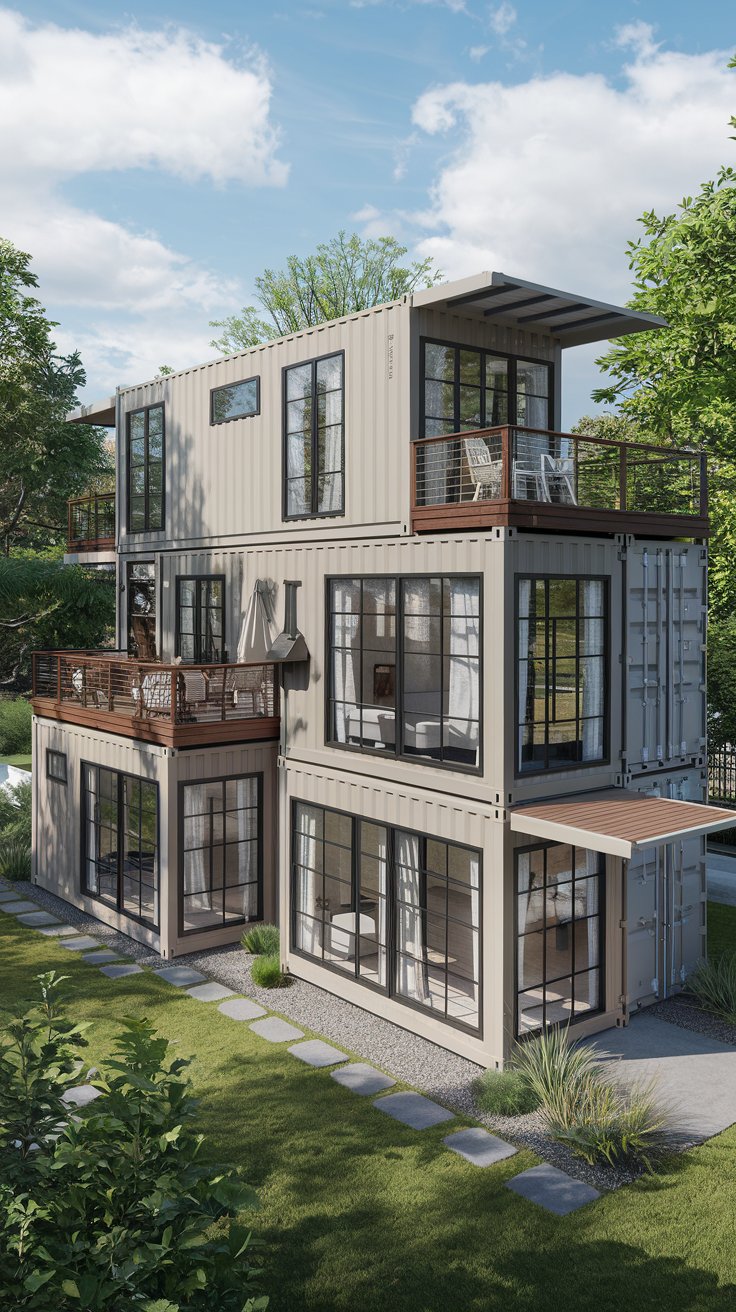
Shipping containers are everywhere. Millions of them sit unused in ports around the world, just taking up space and collecting rust. I saw a documentary about them once—they showed piles of containers taller than buildings, and I thought, “That’s so much wasted potential.” It made me sad—all that steel, just sitting there. But then I learned you can turn these steel giants into cozy, modern living spaces.
I used to think they’d look like… well, a metal box. Cold, industrial, no personality—like living in a storage unit (I’ve rented those. They’re dark, dusty, and smell like old cardboard). But no. People cut out big windows, paint them bright colors (I saw one painted mint green that looked like a beach house!), and even stack them to make lofts. It’s like giving a boring old box a makeover.
My brother-in-law, Mike, is building one right now. I’ve been helping him on weekends—mostly holding tools and handing him nails (I’m not great at the actual building part. I once hammered a nail into his shoe. Oops). I was skeptical at first. “Isn’t this just a metal box?” I asked him. “It’s gonna be freezing in winter.” He rolled his eyes, said “Wait till you see the kitchen,” and kept hammering.
He was right. The kitchen has a concrete countertop he made himself—got cement on his jeans, still hasn’t washed it out. “It’s a badge of honor,” he says. There’s a stainless steel sink and a sliding glass door that opens to a deck (he built that too—with my “help”). It’s industrial-chic but totally cozy—like something you’d see in a design magazine, not a repurposed container. I even told him it looks “fancy,” and he acted like he didn’t care, but I saw him smile.
And it’s fast. They put the main structure up in a week. No waiting 6 months for construction, no dealing with contractors who show up late and blame “traffic” (we’ve all been there). Mike says the whole thing will be done by fall. I’m already planning the housewarming party—bringing a plant, obviously (Gary needs a friend. Maybe a succulent named Sally?).
Plus, it’s sustainable. Repurposing a shipping container means less steel ends up in landfills, and the houses are durable (they can withstand storms—Mike says it’s “like living in a bunker, but cute”). It’s a clever way to turn something old into something new—and it’s way more affordable than a traditional house. Mike says he’s saving about $50,000 compared to buying a regular house. That’s a lot of money for beer and pizza—his two favorite things. I told him he should save some for a new pair of jeans (the cement one’s not gonna last forever). He ignored me.
11. The Cob Cottage Charm: Sculpted Homes with Soul
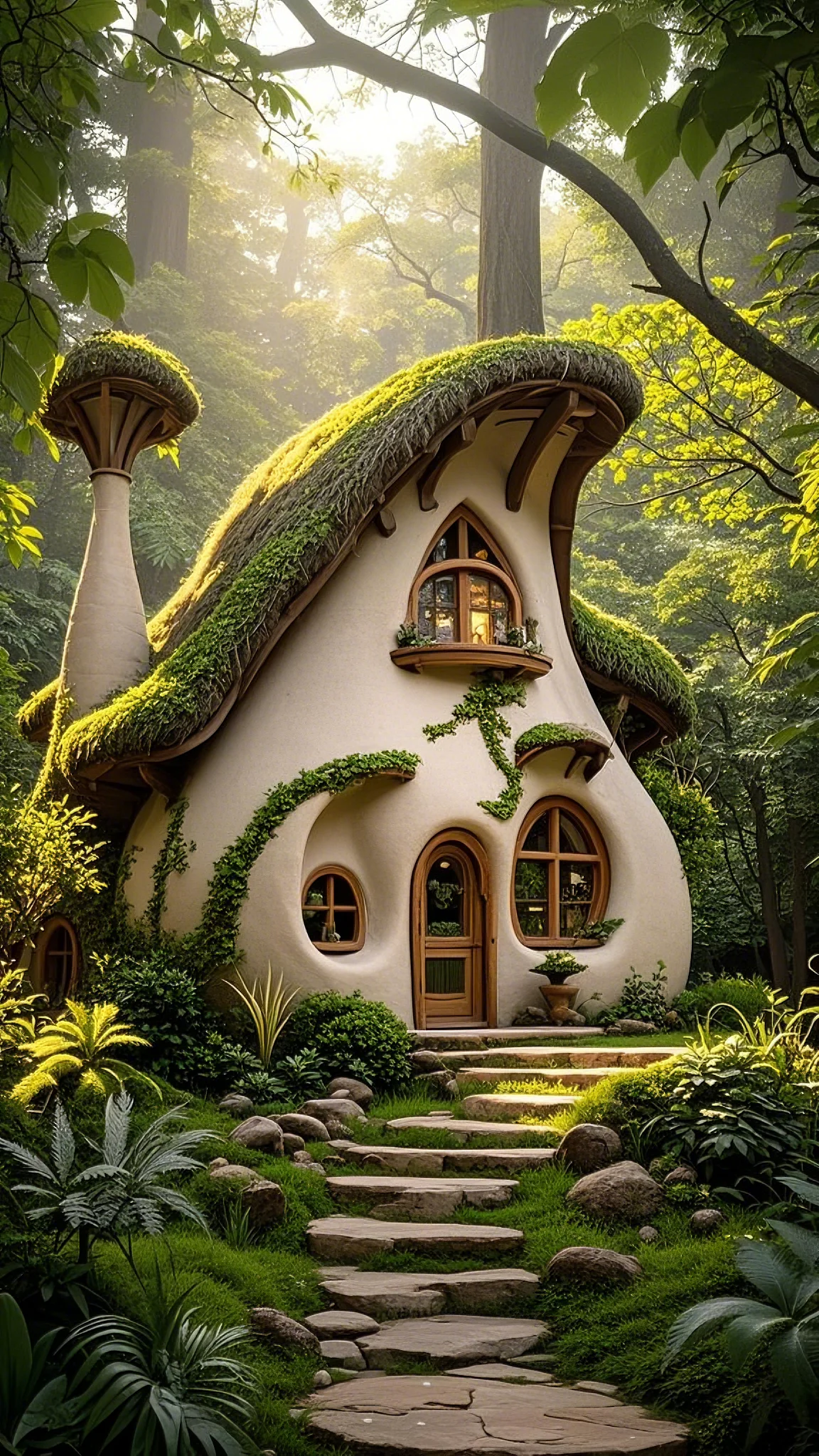
If you want a home that’s truly one-of-a-kind—no cookie-cutter rooms, no “this is how it’s supposed to be” rules—Cob Cottages are it. They’re built with cob—a mix of mud, straw, and water—and sculpted by hand. No straight lines, just organic shapes and cozy nooks that feel like they were made just for you. Like someone took a bunch of mud and said, “Let’s make a house that hugs you.”
I watched a documentary about a couple, Lena and Tom, who built one a few months ago. I was hooked. They spent months mixing cob in a big tub—mud under their nails, clothes covered in dirt, but they were laughing the whole time. They’d throw mud at each other, then clean it off with hoses (they looked like kids playing in a puddle), and go back to mixing. Their dog, a golden retriever named Daisy, kept trying to play in the mud—she’d sneak over, dip her paw in, and run away with a muddy print on the grass. They had to put a little fence around the tub to keep her out, but she’d still sit there and whine. It was cute.
They shaped the walls by hand, adding little curves here and there. They built a reading nook into the living room—complete with a cushion made from old fabric: t-shirts from their college days (Lena had a vintage Fleetwood Mac one that was so faded you could barely see the logo), bandanas, even an old curtain from their first apartment (it had little flowers on it). The end result? A cottage with curved walls, a fireplace that looked like it grew out of the floor, and windows that framed the forest perfectly—like looking at a painting every time you glance outside.
“It feels like the house was made for us,” Lena said, sitting in that reading nook with a mug of tea. Tom nodded and said, “We put so much of ourselves into it. Every curve, every nook—they’re all part of our story.” He pointed to a little indent in the wall and said, “That’s where Lena accidentally leaned against the cob while it was still wet. We kept it because it’s her.”
That’s the magic of cob—you’re not just building a home; you’re creating something that reflects you. Cob is also sustainable—all the materials are natural and easy to find (you can even get the mud from your own backyard, though you might have to fight your dog for it). And it’s warm and quiet, like living in a hug.
Yeah, it’s messy work—my hands would be covered in mud for weeks—but totally worth it for a home with so much soul. I’ve been daydreaming about building a small cob bench for my balcony. Maybe Gary would like it. He could sit on it and stare at Maria’s mint wall.
12. The Prefab Panel Paradise: Sustainable Style, Speedy Construction
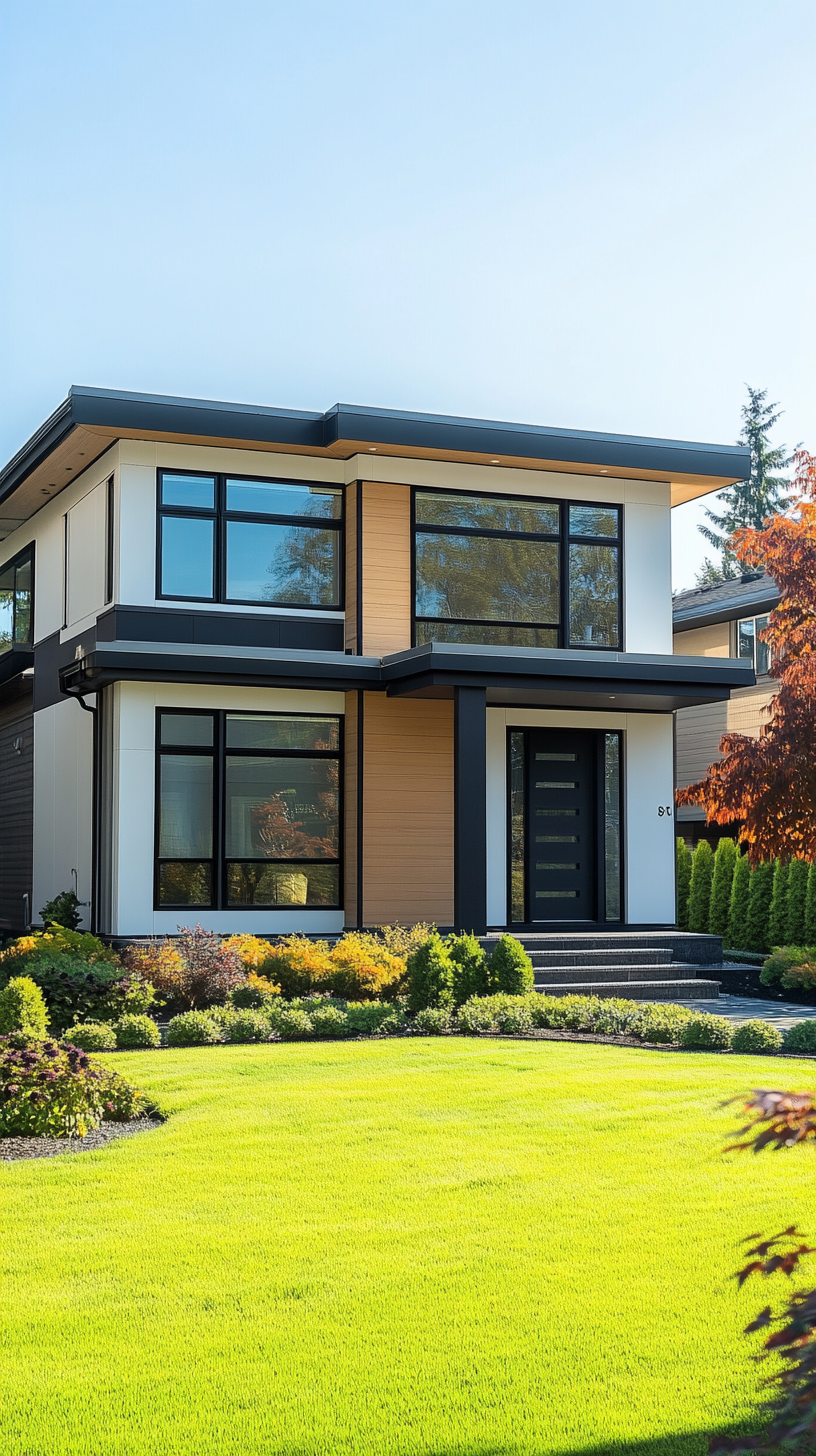
Let’s be real: Most of us don’t have months (or years!) to wait for a house to be built. My friend Sarah waited 10 months for her house to be done. She lived in a rental with her two kids and a golden retriever named Max (yes, another Max—this one shed everywhere. Her couch was covered in fur, and she’d vacuum it every day, but it would be back by noon). By month 8, she was ready to scream. “I’m so tired of living out of boxes,” she’d say, staring at a pile of unpacked toys (her son’s action figures were everywhere). “The kids can’t find their favorite stuffed animals, and Max’s hair is on everything.” I felt for her—living out of boxes is the worst. I did it for a month after moving, and I wanted to throw all my stuff away.
Prefab Panel Homes solve that problem—without sacrificing sustainability. Here’s how it works: The walls, floors, and roof are built in a factory (so no rain delays, no messy construction sites in your yard that your dog tries to dig up). Then they’re shipped to your lot and put together in weeks. Weeks! Not months. It’s like ordering a pizza, but instead of pepperoni, you get a house.
My coworker, Lisa, got one last year. She still talks about how easy it was. She ordered it in March, picked out the style (modern, with big windows—“I wanted light, lots of light,” she said. Her old apartment was dark, and she hated it), and was moving in by May. No rain delays (her old house took 8 months to build because of a rainy summer that turned the construction site into a mud pit—she had to wear boots just to visit). No messy construction sites (she has a dog named Charlie who loves to dig—so that was a win. No more Charlie covered in mud).
And it’s energy-efficient too—she has solar panels built into the roof, and her utility bills are way lower than her old house. “I used to pay $200 a month for electricity,” she told me over coffee (we go to that lavender latte place—her favorite is the honey lavender one). “Now I pay $50. That’s an extra $150 for lattes—and let’s be real, I need the lattes.”
That’s a lot of extra cash for coffee—win-win. Prefab homes used to have a reputation for being “boring,” but not anymore. You can choose from tons of styles—modern, rustic, minimalist—and customize the inside. Lisa added a built-in bookshelf in the living room for her mystery novels (she’s obsessed with Agatha Christie—she has a first edition of Murder on the Orient Express on the shelf, and she won’t let anyone touch it) and a garden tub in the bathroom (she takes bubble baths every Sunday night—her “me time”).
It’s fast, affordable, and eco-friendly. Perfect for anyone who wants to live green but doesn’t have time to wait. I told Lisa I might get one someday. She said, “Just don’t wait till you’re living out of boxes like Sarah. It’s not fun.” I took note.
13. The Rainwater Harvesting Haven: Quenching Your Thirst, Sustainably
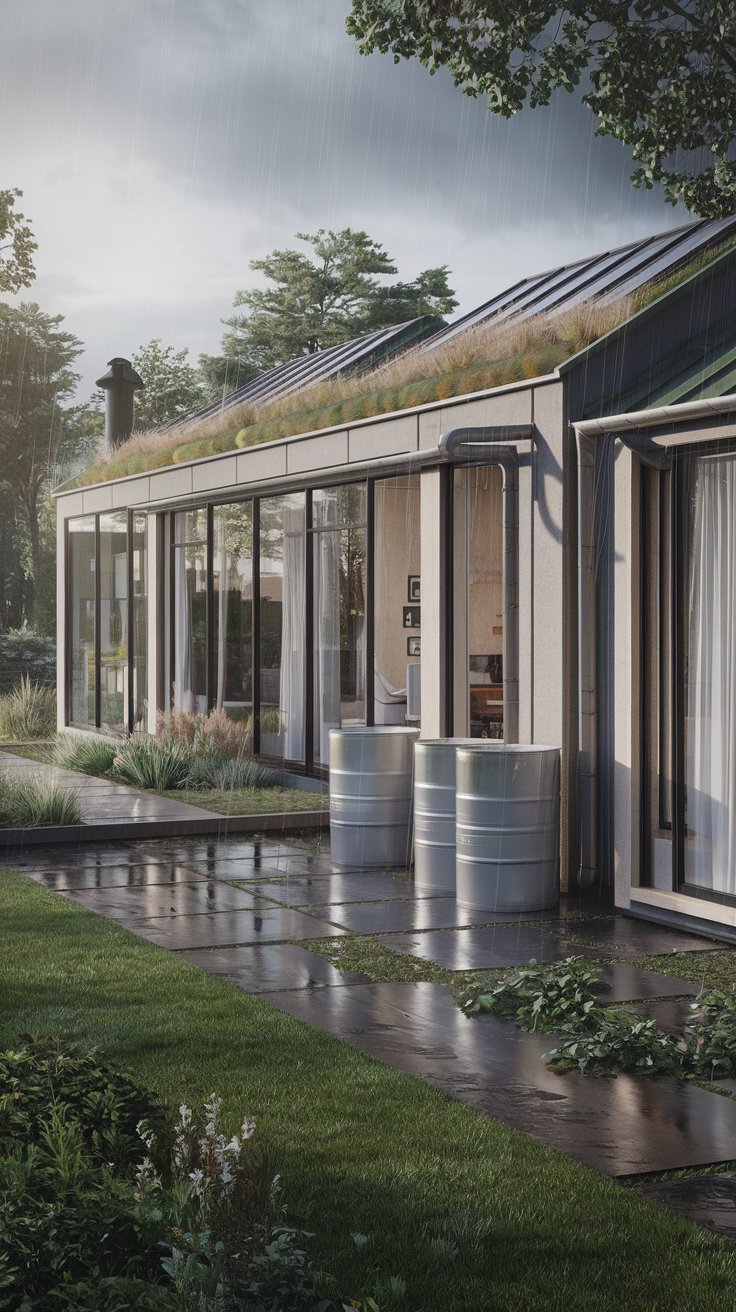
Water is precious—especially when there’s a drought. I remember last summer, my city had a water ban. No watering lawns, no washing cars, and I felt guilty every time I took a shower longer than 5 minutes. “Am I using too much?” I’d think, standing under the spray, watching the water go down the drain. I even timed myself with a song—“Uptown Funk” (3 minutes, perfect)—but I always went over. I’d get to the chorus and think, “Just one more verse,” then suddenly it’s 5 minutes later. Oops.
Rainwater Harvesting Homes collect and store rainwater, so you’re not just relying on the tap. It’s simpler than you think: You put a big tank under your gutter. When it rains, the water flows into the tank. Then you can use it to water your plants, wash your car, or even flush your toilets (don’t worry—you filter it first! No grossness here. I wouldn’t suggest drinking it straight from the tank, though. Stick to tap for that).
My neighbor, Dave, does this. During the drought last year, his garden was the only one on the block that didn’t die. Everyone else’s grass was brown, their flowers were wilted and sad (my tomato plant looked like it was giving up), but his was green and lush—like a little oasis in the middle of a desert. He even used rainwater to wash his dog, Max (yes, another Max—this one’s a labradoodle with curly fur). Max hates baths with a passion—he hides under the bed when he sees the shampoo, and Dave has to lure him out with a treat. But he didn’t mind the rainwater. “It’s softer,” Dave said. “He doesn’t get as itchy after. Now he actually stands still.” Miracle.
Plus, it saves you money. Less tap water used means lower bills—Dave says he saves about $30 a month. That’s enough for a bag of dog treats (Max’s favorite—peanut butter flavored) or a few potted plants (I’d buy more succulents, obviously).
And there’s something satisfying about knowing you’re using nature’s water instead of wasting it. Pro tip: If you ever want to feel like an eco-pioneer, say “The rainwater will sustain us!” dramatically during a storm. Dave tried this with his kids, and they laughed at him. But he said it made him feel cool. I’d do it too—no shame. Anything to make adulting fun.
14. The Greywater Recycling Retreat: Second Chance for H2O
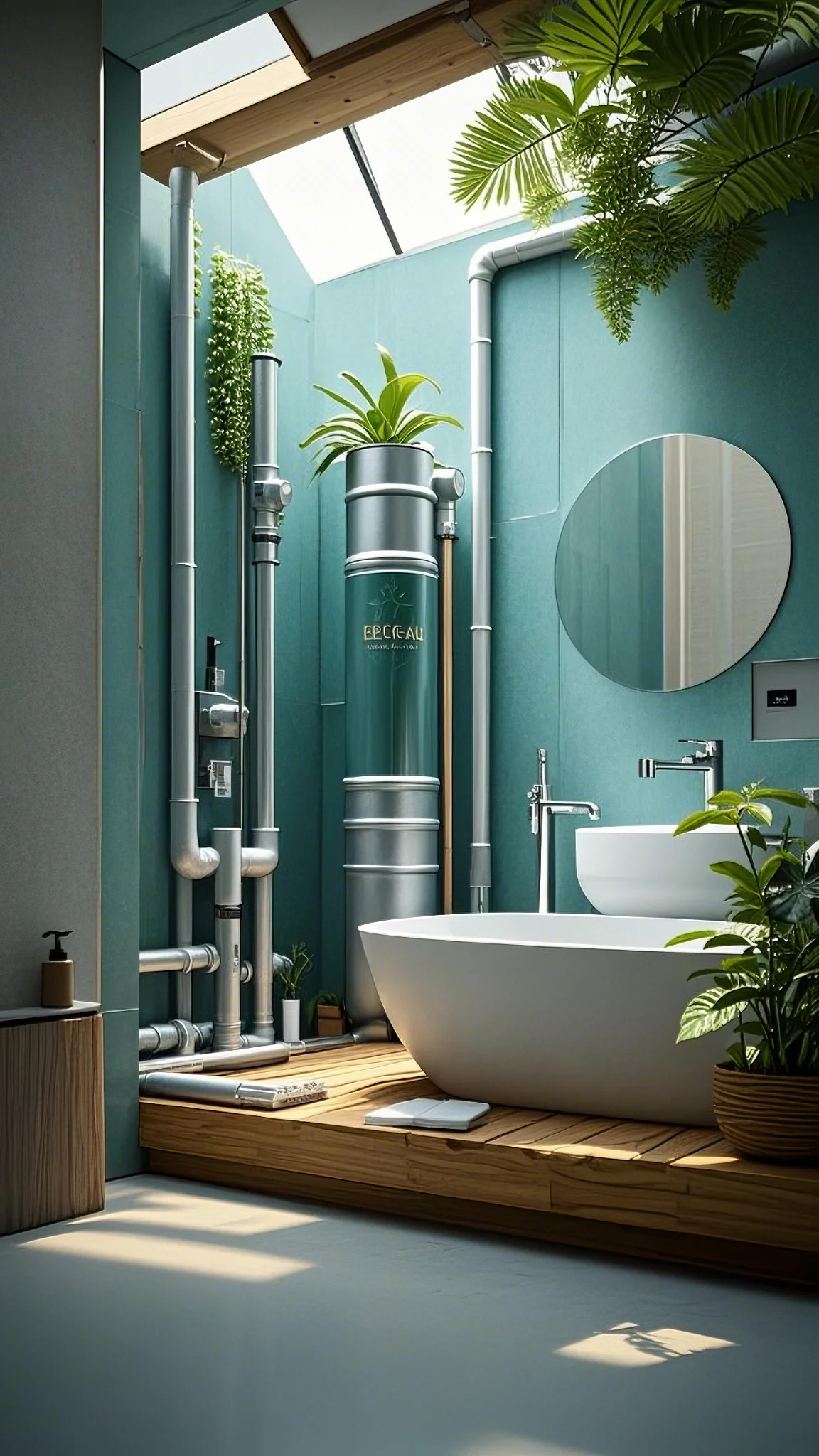
Let’s talk about greywater. It’s not gross—I promise. Greywater is just water that’s been used for showers, sinks, or laundry (no toilet water, so don’t panic—no weird stuff here). It’s like water that’s had a busy day and just needs a second job.
Greywater Recycling Homes clean it a little and give it a second job. Instead of letting it go down the drain, it gets to water plants, flush toilets, or even wash the car. It’s like giving your water a superhero cape.
I installed a simple greywater system in my bathroom last year. I’m not handy by any means—I once tried to hang a shelf and ended up with a hole in the wall that I covered with a picture of a plant (don’t tell my landlord. She thinks it’s a “decorative choice”). But this was easy. It’s just a small tank under my shower that filters the water, then runs a tube to my plants.
First, I hooked it up wrong. The tube was too loose, and water leaked onto my bathroom floor. I panicked, mopped it up, and watched a YouTube tutorial (shoutout to “DIY for Dummies” channels—they’re my saving grace). Second time was the charm. Now, the water from my shower doesn’t go down the drain—it goes to my ferns and my pothos plant (Gary’s friend, Barry. He’s a trailing pothos, and he’s very dramatic).
My ferns used to be so droopy, I thought they were dead. I even considered throwing them away—Gary would’ve been sad, though. But now? They’re full and green, with new fronds popping up every week. Barry the pothos even grew a new vine! It’s curly and reaches toward the window, like it’s trying to say “thank you.” I talk to them sometimes. Don’t judge.
And my water bill went down by $30 a month—enough to buy a few more plants (oops, I have a problem). I now have Gary, Barry, a succulent named Sue, and a cactus named Carl. My balcony’s starting to look like a jungle. My friends joke that I’m turning into a plant lady. I take it as a compliment.
It’s like giving your water a second chance to do good. You don’t need a fancy setup, either. Even a basic system can make a big difference. I got mine from a home improvement store for $100, and it took me an afternoon to install—with the help of a YouTube tutorial and a snack break (chocolate chip cookies, obviously). No plumber needed—just a little patience. And maybe a few curse words when you hook the tube up wrong the first time.
15. The Net-Zero Nirvana: Energy Independence, Pure Bliss
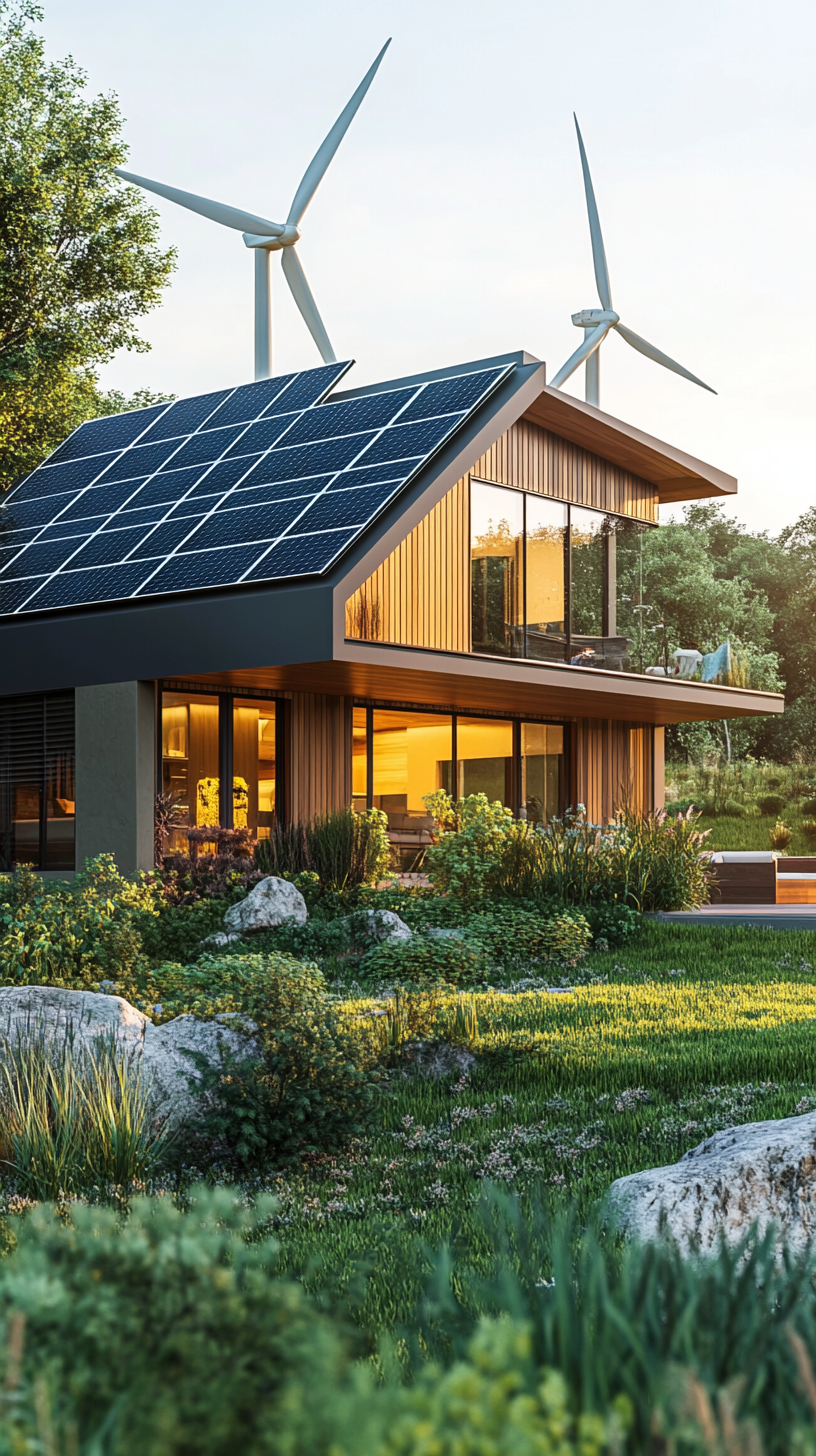
This is the eco-home holy grail: Net-Zero Energy Homes produce as much energy as they use. No more big electric bills (my uncle’s bill is usually $0—sometimes even negative, meaning the power company pays him. He loves that). No more feeling guilty every time you turn on the AC in July (I used to stand in front of the AC, thinking, “Is this worth it?” Now I just do it. No guilt). Just pure, sustainable bliss.
How do they do it? A mix of smart design (good insulation, energy-efficient windows that keep the heat in so you don’t have to crank the heater), renewable energy (solar panels on the roof, a small wind turbine in the backyard that looks like a tiny windmill—my uncle calls it his “little helper”), and smart tech (a thermostat that learns your habits—mine still thinks I’m home at 2 PM and turns the heat up, but his knows he’s at work and turns it down. Smart little thing).
My uncle, Bob, has one. He loves showing off his energy bill at family dinners. We’ll be eating dessert—apple pie, his favorite, with a scoop of vanilla ice cream—and he’ll pull out his phone, wave it around like it’s a trophy, and say, “Look at this—they owe me $15 this month!” Everyone rolls their eyes, but we’re all secretly impressed. His wife, my aunt, just shakes her head and says, “Bob, put the phone away. We’re eating.” But she’s smiling.
His house is also super comfortable—always the perfect temperature, no hot or cold spots (unlike my apartment, where the kitchen is freezing and the bedroom is a sauna. I sleep with a fan in winter. Don’t ask). And it’s quiet—no noisy AC units or heaters humming all night. He has a sunroom where he grows tomatoes—they’re even better than Jake’s green roof tomatoes. Juicy, sweet, and perfect on sandwiches. He gives them to us at family dinners, and we all fight over who gets the biggest one.
He says it’s like living in a “futuristic cabin.” I get it. It’s the ultimate “I’m doing good” win. Plus, you get to feel like a futuristic eco-pioneer every time you check your bill. Who wouldn’t want that? I told my uncle I might get a net-zero house someday. He said, “Just wait till you see the tax breaks. They’re worth it.” I’m taking notes.
Conclusion: Dream Green, Live Greener!
So there you have it—15 eco-friendly homes that prove sustainable living doesn’t have to be boring, expensive, or “hippie-dippy.” It can be stylish, cozy, and even a little fun.
You don’t have to tear down your house and build a bamboo bungalow (though if you want to, go for it—I’ll be your first guest with a housewarming plant and a jar of homemade cookies. I make a mean chocolate chip). Even small changes count—adding a vertical garden to your balcony, installing a rain barrel under your gutter, or using greywater to water your plants. I started with the greywater system, and now I’m thinking about adding a small vertical garden to my kitchen wall (I want to grow herbs—basil, rosemary, maybe some thyme. Imagine fresh basil on pasta? Yes, please).
Baby steps, right? I still forget to water my plants sometimes (sorry, Gary—I set a phone reminder now, so he’s doing better). I still panic when I forget my reusable bag at the grocery store and have to use a plastic one (I keep a spare in my car now, just in case). Eco-anxiety is real—we all have it. But it’s okay to mess up. What matters is that we’re trying.
Building an eco-friendly home is about more than saving the planet (though that’s a pretty awesome perk). It’s about creating a space that’s healthy for you, your family, and the world around you. It’s about feeling connected to nature, even if you live in a city with more concrete than grass. It’s about waking up in a home that makes you go, “I’m glad I’m here.”
So let’s ditch the eco-anxiety. Let’s embrace the inspiration instead. Which of these designs made you go, “Wait, I could actually live in that?” Was it the tire Earthship? The cozy straw bale house? The tiny house on wheels that lets you move whenever you want? Let me know in the comments—I’m always here to geek out about green home hacks.
And if you share this with a friend who’s tired of doom-scrolling? Even better. We’re all in this together—one amazing home (or one small change) at a time. Now, who’s ready to add a little green to their space? Gary’s waiting.
上一篇
13 Stunning Dark Souls Character Illustrations That Will Leave You Breathless!
下一篇
11 Tiny Home Decor Tips That Make Small Spaces Feel Huge (Wait Until You See #6!)
Loading...
